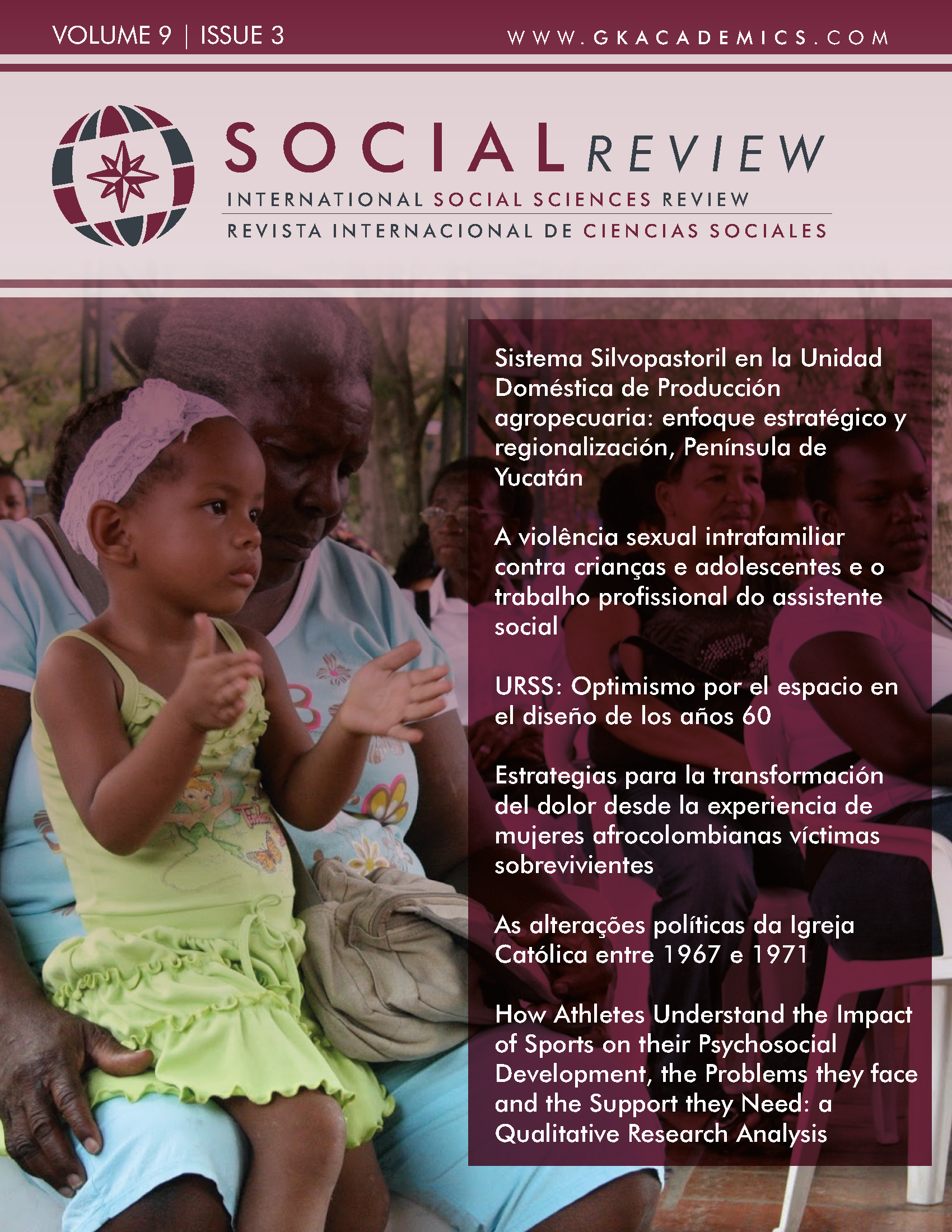How Athletes Understand the Impact of Sports on their Psychosocial Development, the Problems they face and the Support they Need: a Qualitative Research Analysis
DOI:
https://doi.org/10.37467/gka-revsocial.v9.2652Keywords:
athletes’ experiences, athletes-centered model, qualitative researchAbstract
There is evidence to suggest that athletes face multiple challenges during their career from injuries, to pressure from parents, competition, lack of support and so forth. A psychologist is important for helping the athlete overcome individual difficulties and succeed. This study is focusing on understanding the role of sports on athletes’ psychosocial development, the challenges they face and the psychological support they need from the athletes’ perspective. Through a qualitative research analysis, this study shows that a psychologist can have an overarching role and support not only the athlete but also the athletes’ environment such as the coach, parents and teachers. Reflecting this finding, an athlete-centred model is proposed.
Downloads
Global Statistics ℹ️
|
1635
Views
|
1209
Downloads
|
|
2844
Total
|
|
References
Anderson, A. G., Hodge, K. B., Lavallee, D., & Martin, S. B. (2004). New Zealand athletes’ attitudes towards seeking sport psychology consultation. New Zealand Journal of Psychology, 33, 129-136.
Collins, N. L., Dunkel-Schetter, C., Lobel, M., & Scrimshaw, S. (1993). Social support in pregnancy: Psychosocial correlates of birth outcomes and postpartum depression. Journal of Personality and Social Psychology, 65, 1243–1258. DOI: https://doi.org/10.1037/0022-3514.65.6.1243
Constantinou, C. S, Georgiou, M., & Perdikogianni, M. (2017). A comparative method for themes saturation (CoMeTS) in qualitative interviews. Qualitative Research, 17(5), 571-588. DOI: https://doi.org/10.1177/1468794116686650
Deci, E., & Ryan, R. (2000). The ‘what’ and ‘why’ of goal pursuits: Human needs and the self-determination of behavior. Psychological Inquiry, 11, 227e268. http:// dx.doi.org/10.1207/S15327965PLI1104_01. DOI: https://doi.org/10.1207/S15327965PLI1104_01
Dunkel-Schetter, C., Sagrestano, L.M., Feldman, P. & Killingsworth, C. (1996). Social support and pregnancy: A comprehensive review focusing on ethnicity and culture. In G.R. Pierce, B.R. Sarason, & I.G. Sarason (Eds.), Handbook of social support and the family (pp. 375–412). New York: Plenum Press. DOI: https://doi.org/10.1007/978-1-4899-1388-3_16
Dworkin, J. B., Larson, R., & Hansen, D. (2003). Adolescents’ accounts of growth experiences in youth activities. Journal of Youth Adolescence, 32(17), 26-27. DOI: https://doi.org/10.1023/A:1021076222321
Ferraro, T., & Rush, S. (2000). Why athletes resist sport psychology. Athletic Insight, 2, 9-14.
Francis, J. J., Johnston, M., Robertson, C., Glidewell, L., Entwistle, V., Eccles, M.P., & Grimshaw, J. M (2010). What is an adequate sample size? Operationalising data saturation for theory-based interview studies. Psychology and Health, 25(10),1229-1245. DOI: https://doi.org/10.1080/08870440903194015
Gardner, F. L. (2001). Applied sport psychology in professional sports: The team psychologist. Professional Psychology: Research and Practice, 1, 34-39. DOI: https://doi.org/10.1037/0735-7028.32.1.34
Gee, C. J. (2010). How Does Sport Psychology Actually Improve Athletic Performance? A Framework to Facilitate Athletes’ and Coaches’ Understanding. Behavior Modification, Vol. 34 (5), 386-402. DOI: https://doi.org/10.1177/0145445510383525
Gould, D., Dieffenback, K., & Moffett, A. (2002). Psychological characteristics and their development in Olympic Champions. Journal of Applied Sport Psychology, Vol, 14(3), 172-204. DOI: https://doi.org/10.1080/10413200290103482
Guest, G., Bunce, A., & Johnson, L. (2006). How many interviews are enough? An experiment with data saturation and variability. Field methods, 18(1),59-82. DOI: https://doi.org/10.1177/1525822X05279903
Hanin, Y. L. (1995). Individual zones of optimal functioning (IZOF) model: An idiographic approach to performance anxiety. In K. P. Henschen & W. F. Straub (Eds.), Sport psychology: An analysis of athlete behavior (3rd ed., pp. 103-119). Ithaca, NY: Movement.
Hansen, D., Larson, R. & Dworkin, J. (2003). What adolescents learn in organized youth activities: a survey of self-reported developmental experiences. J Res Adolesc. 13, 25–56. DOI: https://doi.org/10.1111/1532-7795.1301006
Hardy, L. (1997). Three myths about applied constancy work. Journal of Applied Sport Psychology, 9, 277-294. DOI: https://doi.org/10.1080/10413209708406487
Hedstrom, R. & Gould, D. (2004). Research in Youth Sports: Critical Issues Status, White Paper Summaries of the Existing Literature. East Lansing, MI: Institute for the Study of Youth Sports, Michigan State University.
Keegan, R.J., Harwood, C.G., Spray, C.M., & Lavallee, D. (2014). A qualitative investigation of the motivational climate in elite sport. Psychology of Sport and Exercise, 15, 97-107. doi.org/10.1016/j.psychsport.2013.10.006 DOI: https://doi.org/10.1016/j.psychsport.2013.10.006
Knight, C., Berrow, S. R. & Harwood, C. G. (2017). Parenting in sport. Current Opinion in Psychology, 16, 93-97. doi.org/10.1016/j.copsyc.2017.03.011. DOI: https://doi.org/10.1016/j.copsyc.2017.03.011
Lafreniere, M., K., Jowett, S., Vallerand, R. J., & Carbonneau, N. (2011). Passion for coaching and the quality of the coach-athlete relationship: The mediating role of coaching behaviors. Psychology of Sport and Exercise, 12, 144-152. DOI: https://doi.org/10.1016/j.psychsport.2010.08.002
Lazarus, R. (1991). Emotion and adaptation. New York, NY: Oxford University Press.
Mainar, S. D., Curry, L. A., Sommers-Flanagan, J., & Walsh, J. A. (2001). Student athlete preferences in seeking help when confronted with sport performance problems. Sport Psychologist, 15, 205-233. DOI: https://doi.org/10.1123/tsp.15.2.205
Malina, R. M. & Cumming, S. P. (2003). Current status and issues in youth sports. In: Malina RM, Clark MA, editors. Youth Sports: Perspectives for a New Century. Monterey, CA: Coaches Choice.
Martens, R., Vealey, R. S., & Burton, D. (1990). Competitive anxiety in sport. Champaign, IL: Human Kinetics.
Martin, S. B., Kellmann, M., Lavallee, D., & Page, S. J. (2002). The development and psychometric evaluation of the Sport Psychology Attitudes–Revised form: A multiple group investigation. Sport Psychologist, 16, 272-290. DOI: https://doi.org/10.1123/tsp.16.3.272
Moen, F., Hrozanova, M., Stiles, T., & Stenseng, F. (2019). Burnout and Perceived Performance Among Junior Athletes—Associations with Affective and Cognitive Components of Stress. Sports, 7, 171 doi:10.3390/sports7070171. DOI: https://doi.org/10.3390/sports7070171
Morling, B., Kitayama, S., & Miyamoto, Y. (2003). American and Japanese women use different coping strategies during normal pregnancy. Personality and Social Psychology Bulletin, 29, 1533–154. DOI: https://doi.org/10.1177/0146167203256878
O’Brien, B.C., Harris, I.B., Beckman, T.J., Reed, D.A. and Cook, D.A., 2014. Standards for reporting qualitative research: a synthesis of recommendations. Academic Medicine, 89(9), pp.1245-1251. DOI: https://doi.org/10.1097/ACM.0000000000000388
Pate, R. R., Trost, S. G., Levin, S., & Dowda, M. (2000). Sports participation and health-related behaviors among US youth. Arch Pediatr Adolesc Med, 154, 904–911. DOI: https://doi.org/10.1001/archpedi.154.9.904
Potrac, P., & Purdy, L. (2004). Graham Taylor. In R. Jones, K. Armour and P. Potrac (eds.), Sports coaching cultures: From practice to theory. (pp. 21-31). London: Routledge.
Purcell, L. K. (2005). Sport readiness in children and youth. Paediatr Child Health, 10, 343–344. DOI: https://doi.org/10.1093/pch/10.6.343
Putukian, M. (2016). The psychological response to injury in student athletes: a narrative review with a focus on mental health. British Journal of Sports Medicine, 50, 145-148. DOI: https://doi.org/10.1136/bjsports-2015-095586
Rees, T., & Hardy, L. (2000). An investigation of the social support experiences of high-level sports performers. The Sport Psychologist, 14, 327 –347. DOI: https://doi.org/10.1123/tsp.14.4.327
Rees, T., & Hardy, L. (2004). Matching social support with stressors: Effects on factors underlying performance in tennis. Psychology of Sport and Exercise 5, 319 –337. DOI: https://doi.org/10.1016/S1469-0292(03)00018-9
Rees, T., Hardy, L., & Freeman, P. (2007). Stressors, social support, and effects upon performance in golf. Journal of Sports Sciences 25(1), 33-42. DOI: https://doi.org/10.1080/02640410600702974
Rees, T., Ingledew, D. K., & Hardy, L. (1999). Social support dimensions and components of performance in tennis. Journal of Sports Science, 17,421 – 429. DOI: https://doi.org/10.1080/026404199365948
Sarason, B.R., Pierce, G.R., & Sarason, I. G. (1990) Social support: The sense of acceptance and the role of relationships. In: Sarason, B.R., Sarason, I.G., and Pierce, G.R. (Eds.): Social Support: An Interactional View, 97-128. New York: Wiley.
Seefeldt, V., Ewing, M., & Walk, S. (1992). Overview of Youth Sports Programs in the United States. Washington, DC: Carnegie Council on Adolescent Development.
Smith, R. E., Smoll, F. L., & Schutz, R. W. (1990). Measurement and correlates of sport-specific cognitive and somatic trait anxiety: The sport anxiety scale. Anxiety, Stress, & Coping, 2, 263-280. DOI: https://doi.org/10.1080/08917779008248733
Suinn, R.M. (1972). Behavior rehearsal training for ski racers. Behavior Therapy, 3,519. DOI: https://doi.org/10.1016/S0005-7894(72)80191-6
Taliaferro, L.A., Rienzo, B., & Miller, M.D. (2008). High school youth and suicide risk: exploring protection afforded through physical activity and sport participation. Journal of School Health, 78, 545–553. DOI: https://doi.org/10.1111/j.1746-1561.2008.00342.x
Thomas, D.R (2006). A general inductive approach for analyzing qualitative evaluation data. American Journal of Evaluation, 27(2), 237-246. DOI: https://doi.org/10.1177/1098214005283748
Undiyaundeye, F. & Ukwayi, G, U. (2015). Counseling Approaches and Sports Issues in Athletics. International Journal of Social Science and Humanities Research, Vol. 3, (1), pp 166-168.
Yerkes, R. M., & Dodson, J. D. (1908). The relation of strength of stimulus and rapidity of habit-formation. Journal of Comparative Neurology and Psychology, 18, 459-482. DOI: https://doi.org/10.1002/cne.920180503
Zakrajsek, R. A., & Zizzi, S. J. (2007). Factors influencing track and swimming coaches’ intentions to use sport psychology services. Athletic Insight, 19, 1-21.
Downloads
Published
How to Cite
Issue
Section
License
Those authors who publish in this journal accept the following terms:
-
Authors retain copyright.
-
Authors transfer to the journal the right of first publication. The journal also owns the publishing rights.
-
All published contents are governed by an Attribution-NoDerivatives 4.0 International License.
Access the informative version and legal text of the license. By virtue of this, third parties are allowed to use what is published as long as they mention the authorship of the work and the first publication in this journal. If you transform the material, you may not distribute the modified work. -
Authors may make other independent and additional contractual arrangements for non-exclusive distribution of the version of the article published in this journal (e.g., inclusion in an institutional repository or publication in a book) as long as they clearly indicate that the work was first published in this journal.
- Authors are allowed and recommended to publish their work on the Internet (for example on institutional and personal websites), following the publication of, and referencing the journal, as this could lead to constructive exchanges and a more extensive and quick circulation of published works (see The Effect of Open Access).













